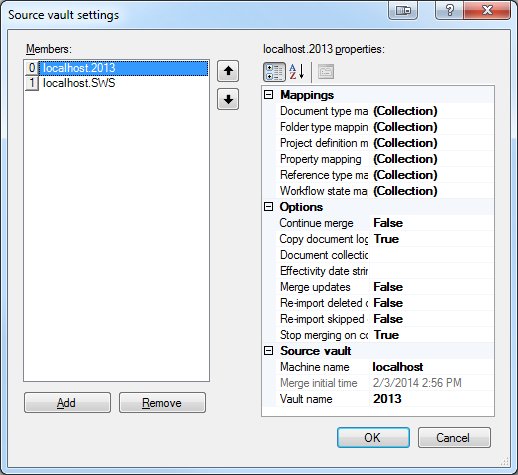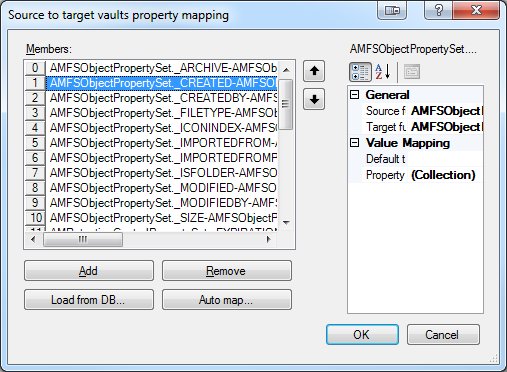Vault merging tool
The BlueCielo Vault Merging Tool was created to help BlueCielo Professional Services consultants and BlueCielo Partners to merge multiple customer vaults into a single vault. The tool provides mapping options for custom properties, document types, folder types, reference types, project definitions, and workflow states. Additional options allow for limited conversion during merging. Controls are provided that allow the process to be divided over multiple sessions.
The tool is available in 32-bit and 64-bit versions. The current version is 9.3.2629.
If the source vaults contain project folders, the Projects merging tool should be run after this tool to synchronize the project folders, folder properties, and their workflows.
Description
To obtain the Vault Merging Tool:
-
Open a ticket with Support to request the file VaultMergeN35.zip.
To install the Vault Merging Tool:
- Extract the contents of the archive file to a location on your PC.
To start a new merge operation:
- Start VaultMerge.exe. The main window of the program appears as shown in the following picture.

- To start with an existing settings file:
- Click Load and select the .vltmrg file.
OR
If you do not want to start with an existing settings file:
- In the Source vaults row, click the collection button
 to select the source vaults that contain the projects that you want to merge. The Source vault settings dialog box appears similar to the following picture. If the tool has not been used before, the Members and properties lists will be empty.
to select the source vaults that contain the projects that you want to merge. The Source vault settings dialog box appears similar to the following picture. If the tool has not been used before, the Members and properties lists will be empty.

- Click Add to specify the first vault. An example source vault is added to Members.
- Type the name of the source vault that you want to merge in Vault name.
-
For each of the Mappings options, click the collection button
 to specify the mappings of the source vault items to the destination vault items. A mapping dialog box appears similar to the following picture. If the item types have not yet been mapped, the Members and mapping lists will be empty.
to specify the mappings of the source vault items to the destination vault items. A mapping dialog box appears similar to the following picture. If the item types have not yet been mapped, the Members and mapping lists will be empty.Notes
- Only those items (documents, properties, and references) with mappings (including built-in items) will be merged into the destination vault. All other items will be skipped.
- The folder type mappings and project definition mappings should be the same for both the vault merge and project merge tools.

-
To automatically map all of the source vault items to identically named items in the destination vault, click Auto map. The Members list is filled with the source vault items. Options for each mapping appear at the right depending on the item type.
OR
To create individual mappings, click Add. A single example mapping is added to the Members list. Options for the mapping appear at the right depending on the item type.
OR
For property mappings only, to load the mappings from an Access database, click Load from DB. The Open dialog box appears, with which you can select the Access database. The database tables must have a specific structure. An example database is provided with the tool. The Microsoft.ACE.OLEDB.12.0 provider must be installed on the PC.
-
Confirm or correct the options for each option of each mapping. For property mappings, you can specify the following options.
| Option | Description |
| Default target property value | A single value to set for this property in every document in the destination vault if the property in the source vault is empty or null. |
| Property value mapping | Mappings of source property values to destination property values. If a matching property value is not found, the source value is set in the destination vault. |
- When you are finished configuring the options for all mappings of an item type, click OK to save your changes and return to the Source vault settings dialog box.
- Repeat steps 3 to 8 for each source vault that you want to merge.
- When you are finished mapping all of the source vaults, click OK to save your changes and return to the main window.
- Click Select Target Vault to choose an existing vault to be the destination. The Open Vault dialog box appears. Select the vault that you want to receive the source vault items and then click OK.
- In the Options group, confirm or correct the settings of the following options:
| Option | Description |
| Continue merge | Resumes a merge operation that you stopped. The default is False. |
| Copy document log | Copies the workflow Comment property of the source documents to the destination documents. The default is True. |
| Document collection name | Type the name of a static collection in the source vaults as the source of the documents to merge. If this option is empty, all documents in the source vaults will be merged. |
| Effectivity date string format | The format with which to set date/time values in the destination vault that are mapped to the virtual source vault properties EffectivityFrom and EffectivityTo. If mapped, these properties contain the effectivity dates/times of the specific revisions of a document. If this option is empty, the properties are assumed to have data types of DateTime. The supported format strings are described in the .NET Framework DateTimeFormatInfo Class topic in the MSDN library. |
| Merge updates | Merges the changes to documents that have been made in the source vaults since they were last merged into the destination vault. When this option is True, the setting of Continue merge is ignored. The default is False. |
| Re-import deleted documents | Imports document revisions into the destination vault that have been deleted there. The default is False, which will generate an error if a destination document has been deleted. |
| Re-import skipped documents | Imports documents into the destination vault that were skipped in a previous merge operation. The default is False. |
| Stop merging on committing errors | Stops a merge operation if any errors occur. The default is True. If set to False and the virtual source vault property StatusMessage is mapped to a destination (string) property, it will contain information about merge errors. |
- If you want to save your settings as a backup, to reuse later, or to resume a partial merge, click Save. The Save merge settings dialog box appears. The default name of the settings file is <MachineName>~<VaultName>.vltmrg. Accept the default filename or correct the name and click Save.
-
To start the merge process, click Start. The progress bar in the status strip shows the progress of the merge.
If you must stop the operation, click Stop. The remainder of the operation will be saved in the file <ComputerName>~<VaultName>.revdb. This file must exist to resume the operation later as described below.
A message box appears when the process has completed. A log file of all actions that were performed during the operation can be found in the program folder with the name Log-<Date>.log. Subsequent runs of the program on the same day append a number to the file extension. The maximum size of each log file is 1 GB, after which a new log file will be started. A new file is also started if the merge is resumed later.
To resume a stopped merge operation
- Start VaultMerge.exe.
- Click Load and select the settings file that you used for the stopped merge operation.
- Set the Continue merge option to True.
- Click Start. The progress bar in the status strip shows the progress of the merge. A message box appears when the process has completed.
Notes
- If the destination folder structure cannot be created for any reason, the document will be placed in the root of the vault.
- Redlines, renditions, and rendition redlines are also merged.
- To import renditions into the destination vault that are stored as discrete documents in the source vault, map the reference type that is used for the rendition relationship to the special RenditionStream reference type in the destination vault. The document in the incoming direction of the reference will be imported as the rendition of the document in the outgoing direction of the reference.
- Merging large vaults can require considerable time and an additional 2 GB or more of server memory. Estimate the duration using the rate of 10000 revisions per hour.
- References are not recreated in the destination vault when the reference or either of its related documents have been deleted. They are also not recreated if one of the documents is located in a different path in the destination vault than in the source vault due to property mappings or default property value settings.
- Documents in work areas are skipped.
